Dr. Marc Golkel was also on the case and remembered the day they got their first rescue call in nearly a year.
"Basically, we got called one day to rescue a bear in very poor condition in the neighboring province, and we immediately arranged the rescue the same day. We went there, did a health examination, and we saw that this bear was in very, very poor health, and this was most likely the reason the owners contacted the local FPD to get rid of the bear."
Almost everyone at the sanctuary was on the case, including Nguyen Thu Trang, who has been a tour guide at the sanctuary for over a year.
"We usually explain to our visitors that our rescuers have a designated spot for necessary gear and goods like medicines and clean water to be brought along on any trip. They usually calculate the appropriate amount of food to bring, but if it's a long journey, they have to think about where and how to obtain more food on the way," said Trang.
She wasn’t on the truck that carried the bears, nor did she operate on them. She waits for them, says hello to them, and tells their stories to sanctuary visitors.
“Khanh, I think, on the way back, licked just a tiny bit of the chicken porridge our team prepared for him. His bladder was an issue, too. An average bear can hold about 500ml of urine in his bladder. But our vets found that Khanh could not urinate at all and was holding in far more. They had to do a surgery to drain the liquid out and it was a painful operation."
Jeremy Lamberton was also on the rescue team for bear Khanh. When asked if he was as hopeful as he is now towards bear Na who they just rescued, he said, "We knew with Khanh that we had a lot of challenges ahead of us, particularly with the inflamed and enlarged bladder. The inability to pass urine is a genuine problem, as Leslie told me. I think we knew with Khanh there were going to be some real long-term issues. The reason we got the call for Khanh was that the owner had noticed that Khanh hadn't eaten in two or three days and had sought to remedy this himself. Find a vet. But there's no veterinary care available for what Khanh needed outside of the bear sanctuary in Ninh Binh, and not even we were able to."
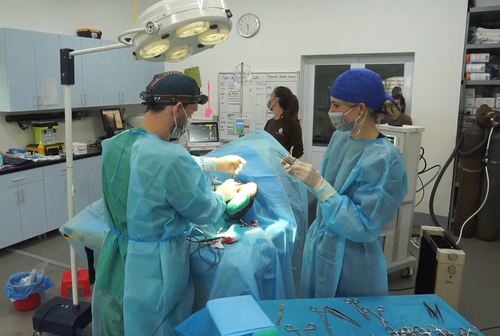 Many bears who arrive at the sanctuary have to receive operations due to their serious conditions. (Photo: FOURPAWS Vietnam) Many bears who arrive at the sanctuary have to receive operations due to their serious conditions. (Photo: FOURPAWS Vietnam) |
"When we checked him, we noted that he had a very large urinary bladder, a very, very large urinary bladder, and over a couple of days we found out that he was not able to pass any urine, so basically his urinary bladder got bigger and bigger and bigger, and we were not able to help him," Dr. Marc Golkel said.
Jeremy, on the other hand, could not spend a lot of time close to Khanh. He, however, was there when the bear passed.
He said, "Khanh's last moments were… Just before he passed, he was trying honey for the first time. Couldn't pass urine… so much of his body was not working. But on his last day he got to try some honey and, you know, we gave him the best possible care until the last moment. And that is something extraordinary."
Khanh tasted honey for the first time, breathed in fresh air for the first time, and according to Jeremy, got a name for the first time.
"With Khanh, it was on Vietnam's National Day. We wanted to choose a name of real significance. It was our first rescue in almost a year and there was something really, really, really special about being able to do it on that day. You know, for us, for our staff, it meant a lot and all of our staff, you know, we had five or six on the rescue, but it felt like all 50 or 60 of our staff were there with us. Everyone follows along very closely, you know, listening to the updates, and all doing and preparing our jobs here to support Khanh. The choice of name was the idea of our head of visitor operations and immediately we knew it was perfect."
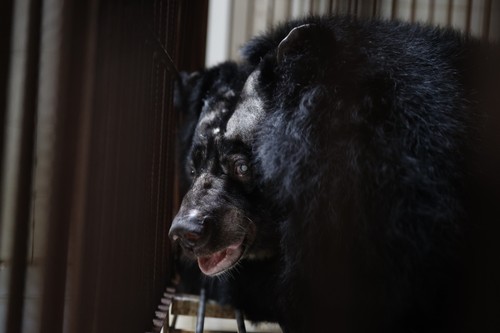 Not even experienced veterinarians can predict what kind of diseases the bears they rescued have to go through. Bear Na, their most recent rescue for example, suffers a serious eye condition. (Photo: FOUR PAWS Vietnam) Not even experienced veterinarians can predict what kind of diseases the bears they rescued have to go through. Bear Na, their most recent rescue for example, suffers a serious eye condition. (Photo: FOUR PAWS Vietnam) |
The life expectancy of an Asiatic black bear is 25 years in the wild, and 39 years in captivity. The oldest recorded was 44 years old. Most bears that arrived at the Bear Sanctuary in Ninh Binh have lived at bile farms for 20, 30 years, and don't have much time left.
Every staff member at the sanctuary understood this, said tour guide Nguyen Thu Trang. "I usually guide our younger visitors to the guest lounge first and show them our bulletin boards introducing the bears. They would ask things like why certain bears are without pictures or why some spots are left blank, and I would tell them about our bears who passed away."
More than anyone else, Lesley, Jeremy, Marc and Trang and other rescuers at the sanctuary understand the meaning of their work and what they are trying for. Whatever the result is, the rescuers at the sanctuary still insist in their effort, as Jeremy put it, "One thing that we get asked is: Was it worth it to go and rescue the bear for only two or three days of their life? Absolutely. Yes."
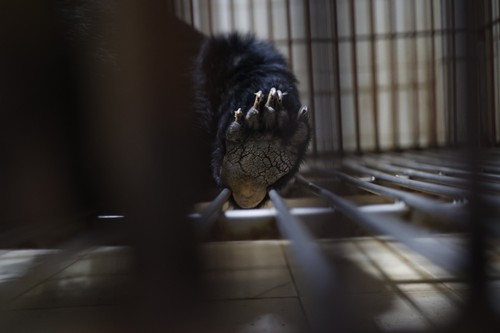 Na's feet show cracks, the results of roughly 20 years in captivity. (Photo: FOUR PAWS Vietnam) Na's feet show cracks, the results of roughly 20 years in captivity. (Photo: FOUR PAWS Vietnam) |
"Obviously, this animal most likely was a wild, caught animal, because she's missing one front paw, most likely from a snare trap. This is how they are usually caught. They don't really breed very well in captivity, at least under the circumstances of the farms, so we can assume that she experienced a life in the wild before, which, for me, makes it even worse, right? This is an animal that was not born in captivity. She knows a different life outside in the wild, the proper bear life, and then you take her into captivity and take away everything, and then additionally also treat her badly and torture her with bile extractions and poor food, lack of any mental input. Yeah, it's shocking," Marc recalled their most recent rescue, bear Na.
In a way, Na’s circumstances were not so different from those before her, from the number of diseases, damaging habits, to self-harms, according to Lesley.
"I mean, she does a lot of stereotyping, but yeah, because she had, like, a chronic infection of the eye, because she had, like, a luxation of the lens in the anterior eye chamber, and this caused a lot of pain. So, she rubbed her head on the bars all the time, and, because they're so bored, they stereotype all the time. That means they have heads weighing or just walking around, doing circles all the time. And sometimes you have bar biting, because they're so bored. Bar biting means that they bite the bars all the time, and it's a reason why they get fractured teeth, and all the enamel around the teeth is destroyed."
But Na is a strange bear. Lesley and Marc said they have seen frightened, aggressive, shy, and very sick bears. Na was different. When asked about Na’s conditions, Marc and Lesley remember every detail about her.
"We did some invasive procedures. We had to remove two canine teeth, which are very large, and you have to remove a lot of bone to get down to them and remove them. She tolerated it very well. She was very, very calm, and we had some nice moments. When we gave her some enrichment, like straw, she was playing and rubbing herself, and then we gave her some Hessian sacks, and she was also playing. There was not a moment where she was stressed. She enjoyed the transport, and then we already started to give her some new food, and she really, really liked dragon fruits, because she had never had any fruits before. The owner told us she doesn't like any fruits. But then we gave her, for example, a banana, and she took it and just ate it, and now here she tried a lot of new foods and was very happy."
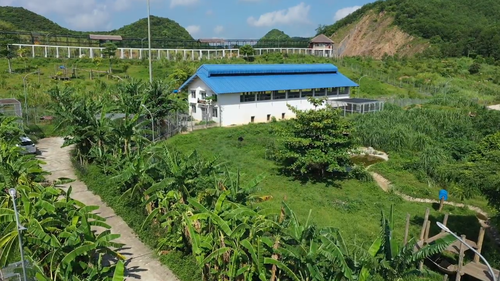 Bear Sanctuary in Ninh Binh, a project by FOUR PAWS Vietnam and bear Na's new home (Photo: FOUR PAWS Vietnam) Bear Sanctuary in Ninh Binh, a project by FOUR PAWS Vietnam and bear Na's new home (Photo: FOUR PAWS Vietnam) |
With access to both the indoor and outdoor enclosures, the bears can finally behave naturally again, after having spent years in dark and tiny cages. They can now choose to swim in the wading pools, climb on the high platforms specifically constructed for their needs, soak up the sun, play with other bears, forage for food or hide away in their dens when they want to relax.
Jeremy told VOV, "This is how things should be. This is what a better life for bears looks like. Bears should be able to enjoy their life, rather than spending their whole life in the small cages that we've seen in the photos."
According to Jeremy, bear Na will be in quarantine for about 2 weeks, and her space will gradually get bigger, and eventually she will join other bears on the 5.5-hectare field, soon to be upgraded to 10 hectares. Or she can choose to live on her own. It's her choice. Four Paws' mission is to give her a choice.
"As an animal welfare organization, we follow our education concept, which is the “one welfare” approach. This approach is to express the interconnection between environmental welfare, animal welfare, and human welfare. The environment and animals have a direct impact on our lives. And our education purpose is to gain awareness, and thus change people's behavior in terms of conservation and reduction of wildlife products consumption," said Jeremy.
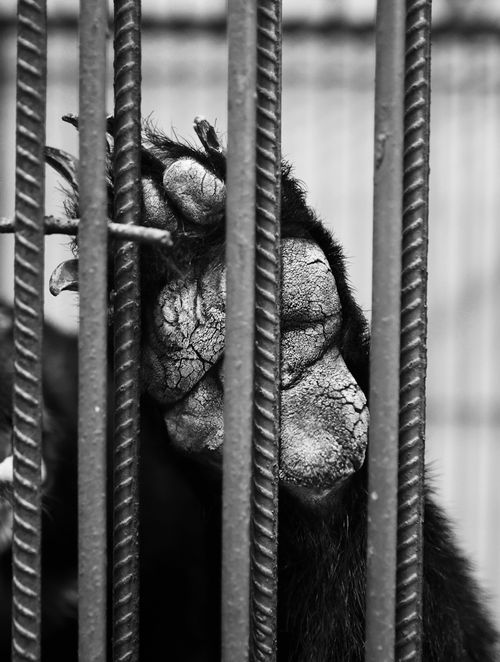 (Photo: FOUR PAWS Vietnam) (Photo: FOUR PAWS Vietnam) |
Their mission is also to educate people on wildlife conservation. This includes visitors, those who use bear bile, and bear farmers.
Jeremy recalled an interaction he had with the bears' owners, "I recall scrolling through photos with Khanh's owner. There was one moment that stands out for me. The bear farmer was crying. She didn't want to say goodbye. She looked at Khanh more in a pet relationship. She had tears in her eyes. I was showing her photos of the sanctuary, and her son, who spoke quite good English, said: Do you really mean Khanh can go there? It was like it was a surprise. They didn't realize the quality of the sanctuary, the ability to be with other bears."
But they know now. And more and more are learning of what's possible, according to Trang: "We have an area called the Skywalk where there are three observatories. The last observatory looks out to a nearby acacia forest and that's where we remember our bears who are no longer with us. Young visitors ask how we bury them, and if we offer them incense. We will soon have a memorial site for the bears. Even now they are already caring for our bears."
For our last question to the staff at Bear Sanctuary in Ninh Binh, VOV's reporter asked how often the bears will get to go outside. Without a shadow of a doubt, they said: "Every day. Every day."
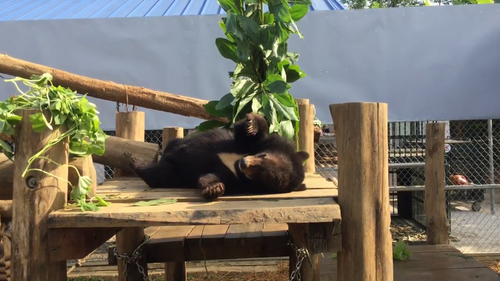 One of the younger bears playing by himself at the sanctuary. (Photo: FOUR PAWS Vietnam) One of the younger bears playing by himself at the sanctuary. (Photo: FOUR PAWS Vietnam) |
UPDATE: On November 29, 2023, bear Na took her first free step in the sanctuary. No longer under quarantine, Na is now with her brothers and sisters at the Bear Sanctuary in Ninh Binh and will enjoy a happy new life here. More information can be found at Bear Sanctuary NINH BINH Facebook page:
Facebook